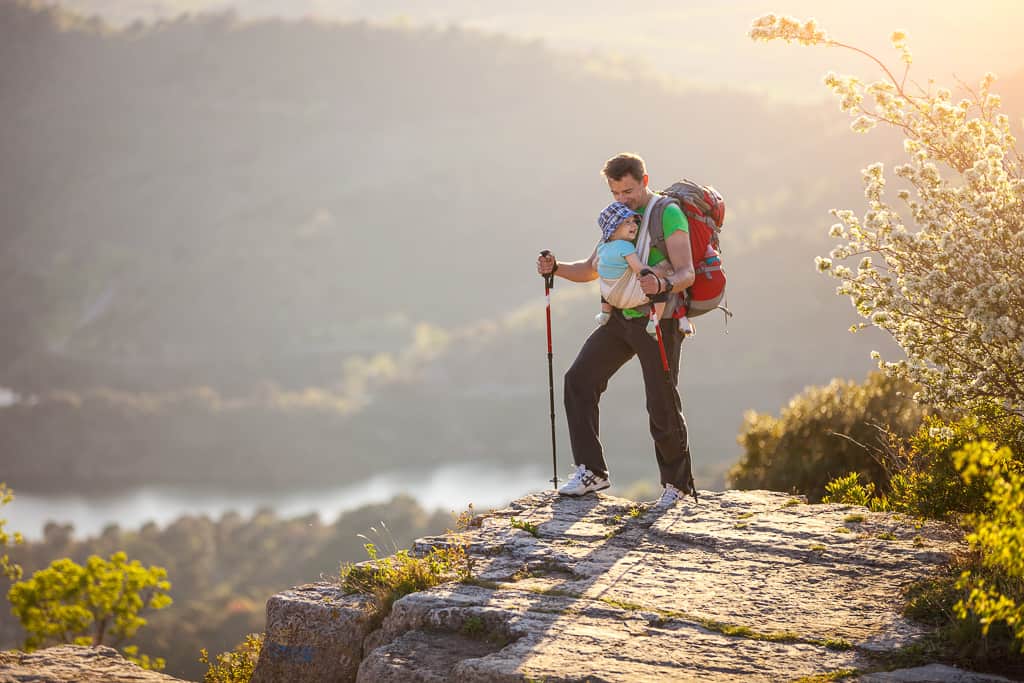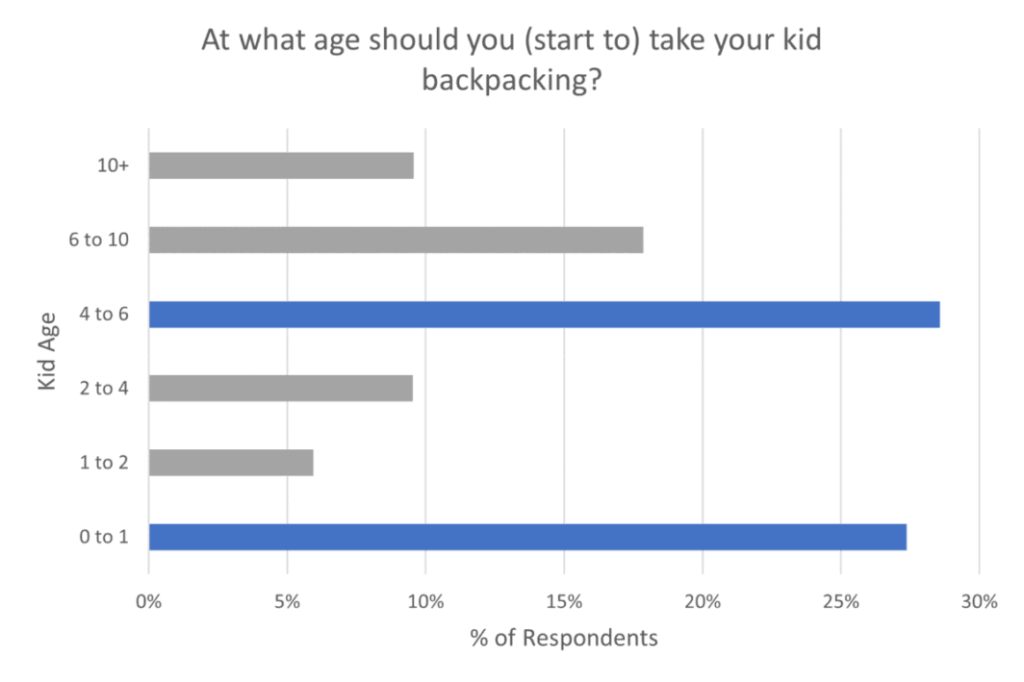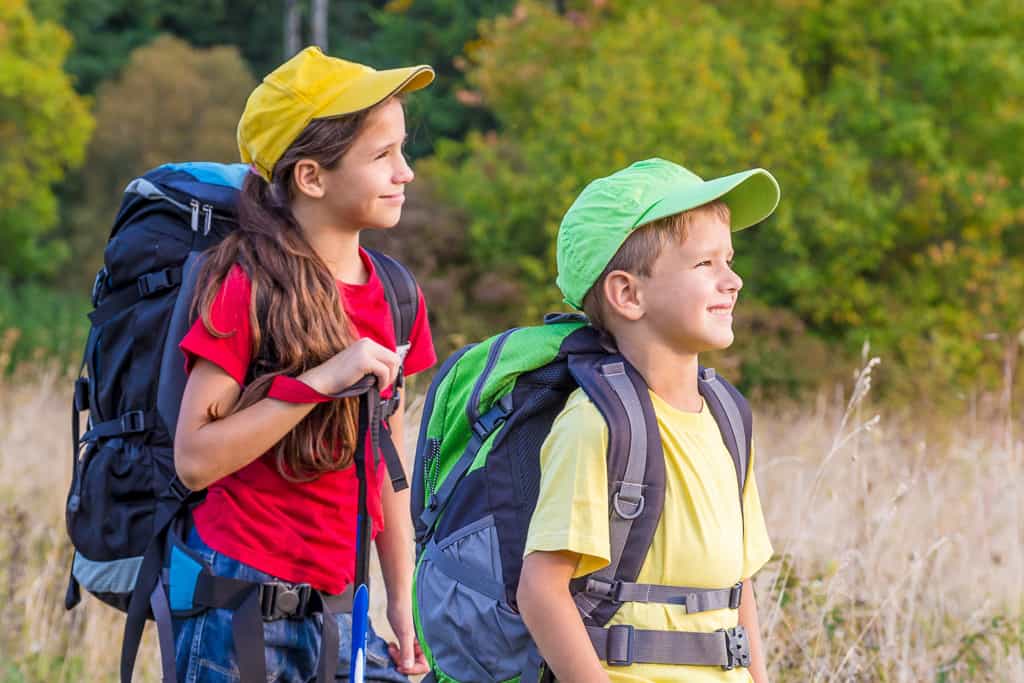
So you love backpacking or the idea of backpacking, but now you have a little one or two to take care of. When can you start to share your passion with the rest of your family?
The best time to try an initial backpacking trip is age 4 to 6, when kids start to keep up with an adult-like pace over short to moderate distances and can carry their own little backpacks. Some experienced backpackers choose to carry their kids with them as infants, but others are simply not comfortable with this risk. Toddlers pose more challenges than other ages as they are heavier than infants and are often extremely slow and prone to falling and frustration. By age 8 to 10, kids can start to take on adult distances and pacing, but may be resistant to the outdoors if not in some way previously exposed to this activity.
We surveyed experienced backpackers and here are the results. Most fell into two camps: kids should start at infancy or 4 to 6 -years old. The terrible 2’s and 3’s may be a good time to take a backpacking pause.
EXPERIENCED COMMUNITY INSIGHTS
Question: At what age should you take your kid backpacking?

Helpful and Common Comments About Backpacking with Kids from the Experienced Community:
- “Expect slow, short and steady to build endurance and confidence in younger kids.”
- “We sometimes had to carry our 3-year-old. That’s quite a lot of extra weight.”
- “Infants are much easier than toddlers. 1 to 2-year-olds will want to walk sometimes, are extremely slow and may fall a lot.”
- “Bring lots of snacks and maybe a distraction like a speaker.”
- “Kids get cranky easily in the heat…Try winter hiking.”
- “Start with day hikes and car camping with little ones until they are 4+.”
- “Trekking poles will save your back (when carrying kids).”
- “Make sure you have bug spray or risk frequent meltdowns.”
- “(After age 3) Hiking and camping gets much easier with time and experience.”
- “Keeping track of and waiting on small, inexperienced walkers can be stressful. Aim for extremely short journeys.”
- “Invest in ultralight gear or bring a wagon to help with the load (carrying kids)…Canoe / kayak camping or rafting may be a better option.”
- “Think about using pack goats or llamas…or an extra adult or two.”
- “Find a spot that is close by and use a front and back carrier together if needed.”
Things to Consider Before Deciding on an Age to Start Backpacking:
#1: Your Backpacking Experience and Conditioning
Backpacking can be a challenge without kids. Is your personal base weight low enough to accommodate dirty diapers, formula and a passenger? You will have to be able to adapt to added challenges like unexpectedly carrying a 3-year-old? There will be little time for your inexperience. Can you navigate so effortlessly that you can always keep an eye on your 5-year-old? In addition to being available to help your kids, you will have to be knowledgeable in and prepared for their special backpacking needs like keeping them cool, dry, entertained and hydrated.
#2: Your Kid’s Experience and Conditioning
What hiking and camping have your kids done and under what conditions? Are these distances and conditions similar to those you will experience on this trip? Just as adults should practice hiking and backpacking before a trip, kids should be conditioned in a safe environment as well.
#3: Your Patience
Kids are unpredictable. Will you have the patience to keep the experience positive? A 3-year-old may decide that she wants to walk with everyone, slowing your pace to 0.5 miles an hour. Will you be happy if you are forced to camp far short of your perfect destination? A rowdy 4-year-old may nearly slide off a steep hill. A hot day or lingering rain may transform your normally pleasant 8-year-old into a super cranky complaint machine. A parent should weigh the risk and impact of these kid-related challenges before he or she chooses backpacking over other family experiences.
#4: The Value of Starting Them Young
Sleeping outdoors with wildlife, walking long distances in various conditions, and eating dehydrated meals can take some getting used to. Kids who grew up with these family experiences are more likely to embrace them than older adolescents who are suddenly asked to adapt to such foreign and seemingly challenging circumstances. Starting backpacking (or some form of camping and hiking) at an early age makes it more likely that this activity will stick.
Pros and Cons of Backpacking at Various Ages

To make backpacking accessible to the whole family, you just need to plan ahead so they don’t end up tired, wet, hot, hungry, thirsty, or emotional.
- Bring appropriate clothing for the weather conditions: There is no such thing as bad weather, just the wrong clothing! Kids are not as resilient as adults, so keeping them comfortable is essential to avoid meltdowns. Synthetics / merino wool and proper layering will help you do that.
- Prioritize hydration: Make sure you carry enough water for the trip out. Kids can surprise you with the amount they need to drink. If it is hot, then cool layers, a hat, and a water spray may help to keep them happy.
- Organize the essentials: It’s your job as the parent to make sure that your kids have what they need. Even as they become more self-sufficient, you should run through a gear check prior to departure as getting this wrong could spoil the trip for everyone.
- Just be prepared: Like a Scout, you need to check the weather forecast and go prepared for any inclement conditions. You might need to abandon your initial plans to avoid a storm that would be too risky to take on with little ones. Preparing a list of risks and how you will address them may help disaster-proof your plans.
If you get these aspects right, you can expect to enjoy many successful adventures with your family. Seeing your experiences through their eyes can even bring you a new sense of discovery, excitement, and wonder.
Backpack Planning for the Family
There is nothing as freeing and stimulating as taking your family backpacking to enjoy the great outdoors for themselves. However, even if you are already an experienced outdoor enthusiast, you may find it a daunting prospect to include your kids. The following tips will help you with that transition.
Itinerary Planning
The first thing is to decide where you want to go and what activities you want to include. If your kids are old enough to contribute ideas, then a family planning session can help to make everyone feel included. Different ages are likely to want different things and if you can incorporate everyone’s interests you will have a more successful trip.
Spend some time doing some research prior to the family meeting to narrow the options and identify some positive aspects (from your family’s perspective) of each option. Snag some online pictures for each hike to make the selection experience more visual.
Draw up an itinerary that has something for everyone. Maybe that’s swimming in a waterfall, stopping to study nature or doing some fishing. Buffer your goals more than you would without kids to allow for unexpected delays. Backpacking with little ones means extremely modest and flexible mileage goals. The group pace has to realistically match the slowest member’s pace. Sometimes that works well, since you may then be closer to an exit if needed.
This is also the time to do some research into park regulations, restrictions, and permits.
Go Shopping
You are going to need the right equipment if your big trip will be successful. Backpacks that are the right size for each person, walking boots or shoes, thick socks, hats, water bottles, and rain gear are all essentials. Hot and wet kids are the most unhappy, so invest in some comfortable cool, moisture-wicking clothes for the kids. Synethetics are cheaper than merino wool.
Of course you will need a tent, sleeping bags and sleeping pads. You may be able to pick up good-quality second-hand equipment at yard sales or online. Rentals are also available online or at REI. This option can help your budget and give you time to test the feasibility of your family backpacking ideas.
Backpacking with kids means taking first aid even more seriously. Make sure your first aid kit contains everything you need for a safe trip.
Practice Makes Perfect
Before you set off on your first big trip, you will need to test out everyone’s walking legs. This training will give you an idea of your family’s abilities and endurance.
Short local trips in walking gear and backpacks will ensure that everything fits and is suitable. Test out what each child can carry and how often they need to rest. You can dial in your plans and gear after your local practice.
If tent-sleeping is a new thing, consider a couple overnights in the backyard. Too much novelty at once can be a challenge with kids and adults.
Planning a Trip with an Infant or Toddlers
Backpacking with infants and toddlers requires more planning and adapting than with older children, but getting them started young means they will develop a love for the outdoors and set you up for many years of family adventures.
Infants
Infants sleep a lot, are relatively light will not demand to walk on their own. These are some reasons why experienced backpackers will start kids so early. You will likely need to limit the length and duration of your trip with all the added baby weight and baby supplies.
Choosing a Baby Carrier
Your basic baby carrying choice is between a backpack or a sling. Under six months, a front sling is the perfect way to carry a baby. Once they are older you can transfer them into a backpack. It’s worth trying out the different brands to see what suits you. If there are two adults, then make sure the carrier is adjustable for you both to take turns.
Ideas for Backpacking with an Infant
- Practice using the carrier before you head out on your trip. Not only will the baby get used to it, but you can build up your stamina too. Naptimes are perfect for hiking as the motion usually sends a baby to sleep.
- Be aware of the weather conditions. Young babies cannot regulate their temperature so extreme weather is not good for them. Protect their faces from the sun with a hat.
- Pack water as well as milk for babies and use a cool bag to keep them insulated. You will need diaper waste bags to carry dirty diapers until you can dispose of them safely.
- Don’t be too ambitious on your first trip. A few hours of hiking will probably be enough to start with.
Toddlers
Once your little one can walk a little, they will want to stretch their legs often, but may not be able to go too far. Toddlers have an amazing amount of energy, and they will appreciate some safe flat land to run around on, but hiking will tire them quickly.
Ideas for Backpacking with a Toddler
- Toddlers don’t need walking boots. A well-fitted pair of sneakers will be best for their little feet.
- Let your toddler carry a small backpack but don’t overfill it. A lightweight pack will make them feel important without loading them down. Let them choose a colorful water bottle so they will be happy to keep hydrated.
- Plan your walking ahead so you don’t end up carrying them too much. They do tire easily and carrying them a long distance is hard work. Have lots of breaks so they can recover.
- Part of the fun is letting them get muddy and they most definitely will if given the opportunity! Have spare clothes but only change them when they get wet and uncomfortable.
- Plan for lots of time to stop, rest, snack, wander and wonder. Try prompting some curiosity and imagination as you go, so that your toddler sees the trip as more than travel to a destination. It’s easy to otherwise get into an “Are we there yet?” mindset.
Safety
Toddlers seem to know how to act out around the most dangerous features and conditions on trail. Plan the route carefully to avoid steep drop-offs, fast rivers, extreme temperatures and other hazards.
Younger kids should always remain in sight of Mom or Dad. You can let them go ahead and wait for the adults by giving them markers to stop at such as a trail sign.
It’s a good idea to let them have a whistle that they can use to signal if they get lost. Teach them to stay in one place and blow their whistle three times.
Planning a Trip with 4 to 12 Year Olds
The good news is that once your child ready for school, he or she will be ready to start to become a great little hiker. Their independence is a relief, but safety remains a priority.
Ideas for Hiking Trips with 4 to 12 Year Olds
- Keeping kids engaged is the goal. Especially for younger kids, incorporate structured activities like scavenger hunts and geocaching to keep them going.
- Tweens may like more adventure. Maybe make time for some basic rock scrambling or water activities.
- Tweens may also prefer to hike with siblings and chat or play as they go. Give them a bit of space and you will be surprised by how much less they complain when in their own world. This assumes they are generally calm and won’t be at risk of getting into a random pushing match near a steep drop. Bear country is another instance where groups need to stick close of course.
- Map reading is a great skill for kids to learn at this age. Nature trail maps are a great way to start and then progress to topo maps when they are ready.
- Encourage them to appreciate and respect nature and help them to feel they are taking care of the environment by leaving no trace.
Planning a Trip with Teens
Backpacking with teens can be tricky if they are not already accustomed to the outdoors. Persuading them to be enthusiastic when their idea of a good time is playing on their gaming console may prove difficult. The best way is to lead by example. Show them how much you enjoy the outdoors, and they may be encouraged.
Ideas for Backpacking with Teens
- Reward them with a campfire, hot chocolate, and toasted marshmallows at the end of the day.
- Give them permission to invite friends along and promise them some space on the trail, assuming they are responsible and familiar with safety and navigation, just in case.
- Introduce them to freedom of through-hiking culture by sharing a YouTube channel or two (or inspirational documentary).
- Think about their level of fitness and make the first big trip beginner friendly. You want the first trip to be a success and overtired and over-stressed teens will probably refuse a repeat performance.
- Teens like to sleep in. Pass on the pre-dawn starts that you may typically do solo.
- Keep their load lighter than yours. Yes, your teen may well be capable of carrying more, but too much weight may take a bigger toll on their mindset.
- Ask your teens to help choose any new gear. Set a budget and work out how much can be spent on each item. It’s a balance between quality and cost but letting them take part will help them learn how to make such budgeting choices. There are lots of trendy and stylish options for outdoor clothing that your teen may prefer.
- Use their love of technology to find research and maps that will be helpful in the planning of the trip. Once they have learned to read maps, let them navigate. You can always check their plans.
- Include activities that appeal to their sense of adventure. They will love taking photos for social media and showing off their achievements.
